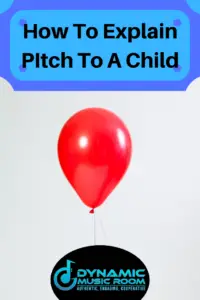Are you a big advocate for teaching broad musical concepts to your younger students?
Do you struggle to find the right words to describe pitch?
Pitch is one of those concepts that provides a building block for many other musical ideas. Getting the foundation established early on and correctly with your younger students sets them up for musical success in later years.
You need to know how to explain pitch to a child.
Explaining pitch to a child may seem tricky, but with intentional work, it’s not hard at all. In its basic form, I explain pitch to kids as how high or low a note or sound goes. From there, we do different types of learning activities to help students become more aware of pitch.
Check out the rest of this post for more details and a few simple activities to use with your students today.
Table of Contents
What Is Pitch?
At its bare-bones, pitch is how high or low a sound is.
In more complicated terms, pitch is measured by the frequency of a sound.
There are 12 pitches in western-style music, and they repeat through octaves. Over the years, these pictures have fluctuated on their exact frequency, but traditionally the 12 pictures are based around the frequency of A = 440 Hz.
The number is based on the number of vibration cycles per second. Therefore, an A tuned at 440 Hz would cycle 440 times per second.
Based on this, take a look at this quick chart on the frequency of each pitch.
| Pitch | Measurement in Hertz (Hz) |
| C5 | 523.25 Hz |
| B4 | 493.88 Hz |
| Bb/A#4 | 466.16 Hz |
| A4 | 440.00 Hz |
| Ab/G#4 | 415.30 Hz |
| G4 | 392.00 Hz |
| Gb/F#4 | 369.99 Hz |
| F4 | 349.23 Hz |
| E4 | 329.63 Hz |
| Eb4 | 311.13 Hz |
| D4 | 293.66 Hz |
| Db/C#4 | 277.18 Hz |
| C4 | 261.63 Hz |
Notice, pitches are not incremental in their frequency.
If you go down one octave from a certain pitch, the frequency is cut in half. A4 is 440 Hz, and A3 is 220 Hz.
In reverse, going up one octave results in a frequency twice of what it started on. A4 is 440 Hz, and A5 is 880 Hz.
This is a more complicated view of pitch than what you might want to share with the child, but I usually introduce these ideas with my older elementary students.
Certainly, if you’re teaching secondary students, this is a great topic of conversation easily tying into intonation.
Teaching Pitch To Elementary Students
When teaching anything, you always want to make sure you offer different learning styles in your activities.
At the very least, you should present an activity aurally, kinesthetically, visually, and creatively. In this section, I’ll offer 4 quick activities I use when teaching pitch to kids.
Kinesthetic Activity: Growing Tree/Seed
When I first introduce pitch, I always start with getting the kids moving. Pitch is a hard concept to talk about, so getting them moving will help them develop knowledge at its basic level.
There are many kinesthetic activities I cycle through, but the Growing Seed is one of my all-time favorites. I use this game in my combo activity I call the Tree Cycle (click the link for the description of the whole set).
The Growing Seed/Tree portion of the cycle goes like this:
- Students curl up on the ground in a ball like a seed.
- I tell them they need to grow by listening to the magical recorder/flute/piano.
- When the recorder plays higher, they grow up. And vice versa. (I just played two octaves up the pentatonic scale.)
- Start just by slowing going up and down.
- Vary the tempo of your playing for a twist.
- Only go up halfway before returning to see if they hear the difference.
- Repeat and add your own twist.

Aural Activity: What Pitches Are These?
Though any activity you do in music will have some aural part to it (music is sound, after all), you still need to provide some focused activities for aural learning.
For this, you need at least four shapes drawn on the board:
- Curve low to high
- Curve high to low
- Curve low-high-low
- Curve high-low-high
Each shape is also given a number 1-4.
Play notes or sing matching the shapes on the board. Students must show the shape it matches by holding up a finger matching the number of the shape.
As with all activities, model the whole group first for the best results.
Visual Activity: Picture Sorting
Another important in-road to developing a concept of pitch is visual learning. As with all forms of differentiation, you’re building the most neural pathways in the brain by reaching students with different activities and where they’re at.
One of my favorite ways to reach visual intelligence is by picture sorting. I’ll look up and print off a bunch of pictures of different animals and things in life.
First, I’ll print off these pictures in large print, and we’ll sort the sounds into high and low pitch as a whole class.
Another day, I’ll provide similar, but smaller, pictures and a T-chart for separating in small groups.
Here’s a link to the pictures and chart I use:
Creative Activity: Pitch Shapes
Creative learning is also important for building knowledge. Intentional creation shows the highest levels of understanding.
For this activity, students are creating a shape to show the pitch of something they want to hear.
First, I model drawing a shape (like a curve or squiggle of some kind) on the board. I talk about how I imagine a sound moving from high to low to match the shape I draw.
Then, I go to the piano/recorder and play a tune based on the contour of the pitch shape.
Students are given note cards and do the same thing with their own ideas. Then, you play their ideas for them on an instrument.
Note: Place emphasis on your thought process before you draw. Students need to think, not just free draw for this to be intentional.
You may also want to check students can describe how the shape matches pitch.
Note: This also leads into melody activities.
Conclusion
I hope you enjoyed learning about how to explain pitch to a child and some activities to use along with it. There are many other ways to do it, but if you use the key words, high and low, along with differentiated activities, your students will be just fine.
What are your favorite pitch activities? Let us know in the comments.

